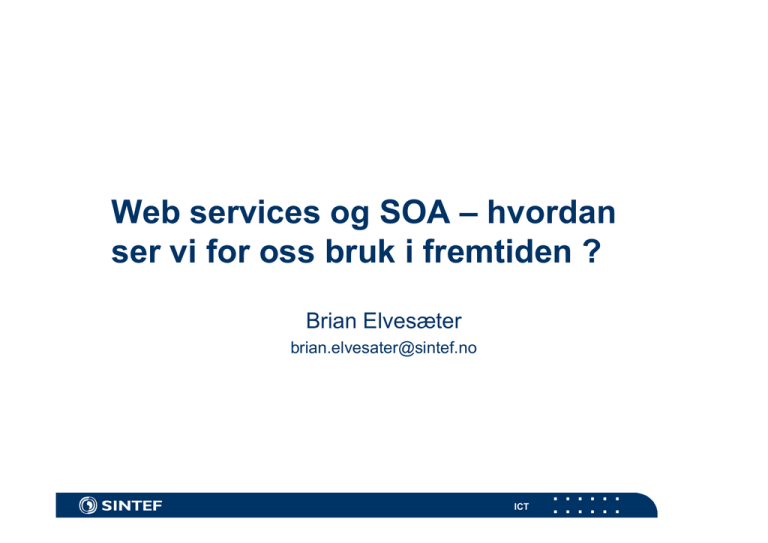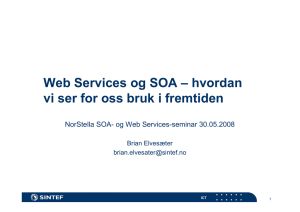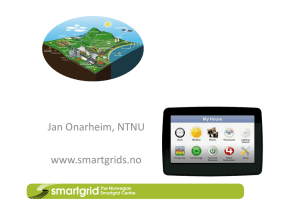Web services og SOA – hvordan Brian Elvesæter
advertisement

Web services og SOA – hvordan ser vi for oss bruk i fremtiden ? Brian Elvesæter brian.elvesater@sintef.no ICT Outline Hvilke adopsjonsrater og trender ser man i bruk av WS/SOA? Hvilke relaterte arkitekturer og teknologier vil introduseres i kjølvannet av WS/SOA? Interoperabilitet og systemintegrasjon SOA referansemodell Web services Teknologiplattformer for SOA Forskning og utvikling på SOA ICT Interoperabilitet og systemintegrasjon ICT Rationale for interoperability Interoperability is the key to increase competitiveness of enterprises. “Enterprise systems and applications need to be interoperable to achieve seamless operational and business interaction, and create networked organizations” – European Group for Research on Interoperability, 2002 Application integration license revenue System implementation budget Misc. 20% B$ Integration 40% Hardware 10% Imp. Services 20% Software 10% The cost of non-interoperability are estimated to (Source: the Yankee Group 2001) 40% of enterprises IT budget. ICT Holistic approach to interoperability Enterprise A Enterprise B Application ICT Knowledge Application Data Data Semantics Knowledge Business Semantics Business Interoperability (def.) is “the ability of two or more systems or components to exchange information and to use the information that has been exchanged” – IEEE Standard Computer Dictionary Communication To achieve meaningful interoperability between enterprises, interoperability must be achieved on all layers: Business layer: business environment and business processes Knowledge layer: organisational roles, skills and competencies of employees and knowledge assets ICT layer: applications, data and communication components Semantics: support mutual understanding on all layers ICT Motivation Enterprise ICT Challenges Business agility Flexibility and adaptability Enterprise architecture frameworks + Holistic approach + Different views of an enterprise as related (visual) knowledge models - Current enterprise architectures are only blueprints Challenges Inflexible and difficult to adapt Enterprise application integration (EAI) Service-oriented architecture (SOA) + Architectural style + Loosely coupled systems + Horizontal integration between different business domains + Use case oriented service composition +/- Web services (enabling technology) Requirements Enterprises require operational enterprise architectures ICT solutions must be designed to be inherently interoperable ICT SOA and integration Fundamental change for integration: X <-> Y Pre-SOA: outside, after development Post-SOA: inside, integral part of development / computational model Consequences How should integration be done? Innovation and experience Competition, expansion, consolidation Not understood: IDC Directions 2006 (3/2/06): SOA important but not understood or deployed as claimed Gartner (2/15/06): “Globally, organizations placing minor emphasis on understanding the role of data integration in SOA and creation of data services at the foundation of their architectures” ICT History of integration 1950 – 2006: Integration = develop then integrate 1950s-1970s: Simple, manual integration 1970s-1980s: Distributed Computing Applications (interoperation) Databases (integrate) 1990s: Business Driven Integration – concepts, technologies, and tools – increased automation, internet-based computing Concepts: Workflows, Processes, Web, Integration solutions blossom (diverge): ETL, EAI, BPM, … 2000: SOA Emerges 2000: Web services 2003: Integration solution evolution accelerates, vendor chaos ensues 2005: Growth in all integration categories ICT Integration in SOA 2006 – 2012: Integration = dominant programming model 2001-2010: Wrapping 2005-2010: Re-Engineering 2006-2008: Consolidation 2006-2008: Research on Semantic SOA 2007-2012: Emergence of SOA Platforms and Solutions 2006-2012: Problem Solving Era: IT/integration relegated to low level function ICT SOA referansemodell ICT Service-oriented model Service provider Provides software applications for specific needs as services. Service requester A requester could be a human user/application program/another service accessing the service through a desktop or a wireless browser; it could be an application program. Service broker: A service broker provides a searchable repository of service descriptions. Examples of service brokers are UDDI (Universal Description, Discovery, and Integration). ICT Extended service-oriented architecture Market maker Service operator Management Role actions Mark •Certifiect •Ratin ation •SLAs g Oper •Assuarations •Suppornce t performs publishes uses becomes Managed services Compos ition Compos ite servic es •Coordin ation •Conform ance •Monitor ing •QoS Service provider Basic ser vices Descrip tion & B asic Op •Capabil erations ity •Inteface •Behavio r •QoS •Publica tion •Discove ry •Selectio n •Binding Papazoglou and Georgakopoulos CACM, Oct. 2003 Service client Service aggregator ICT ICT OASIS SOA Reference Model (RM) Web services ICT Web service definition Web service “Applications identified by a URI, whose interfaces and bindings are capable of being defined, described and discovered as XML artefacts. A Web service supports direct interactions with other software agents using XML-based messages exchanged via Internet-based protocols.” (W3C) http://www.w3.org/ SOA ~ architectural style Web services stack ~ technology/protocol standards SOA =/= Web services ICT The Waves of Client/Server Technology First Wave Second Wave Third Wave Fourth Wave Fifth Wave MDA, Web Services, .Net Server-side Distributed Service-oriented componentsc Objects Architecture J2EE/EJB OMG CORBA SOAP, XML COM+ COM/OLE WSDL/WSFL Corba Comp Web/Internett Agents, P2P Java File Servers FIPA 1982 1986 1990 1994 Grid 1998 1999 2000 2001 2002 2003 Base Source: Client/Server Survival Guide, 1994 Robert Orfali, Dan Harkey OS/2 Edition, VNR Computer library + AJB update 2004 ICT User Interface Document model Web interaction Synchron. request Deferred Synch request Interaction/Pres services XML Message Streaming Multi Media, QoS Event - publish & subscribe Workflow service User services (application/process) System/Use Mngt Server Components Shared Business Services Concurrency service Naming service Security Trading service service Data services & Legacy systems Integration service Transaction service Persistence service ICT + real-time/min. CORBA + Firewall + QoS + ... CORBA ORB w/IDL CORBA Dynamic API Corba Messaging Service Event & Notification service XML, IIOP mapping Interaction/Pres services Workflow service User services (application/process) Corba Components (CCM) Shared Business Services Concurrency service Naming service Security Trading service service Data services & Legacy systems Transaction service Persistence service ICT Web services architecture Web services can be used to implement serviceoriented solutions They adhere to the set of roles and operations specified by the service oriented model. They have also managed to establish a standardized protocol stack. ICT Web services og port 80 Interessen for Web-tjenester har mye av sitt utgangspunkt i problemet for CORBA, MS DCOM og Java RMI med å slippe igjennom for kommunikasjon med ukjente klienter, på grunn av sperrer i brannmurer. Det ble raskt oppdaget at port 80 (for http Web-browser) kommunikasjon var åpen i de fleste brannmurer, og man begynte å pakke inn informasjon (tunneling) i meldinger som ble sendt gjennom port 80, først innpakket i HTML, deretter i XML. Dette gav både en teknologi- og markedsmulighet som først Microsoft, deretter IBM var tidlig ute med å utnytte og promotere. ICT IIS, ASP+ XML/HTML WSDL XML/XSLT Interaction/Pres services SOAP WebServices BPEL4WS User services (application/process) HTTP Web Transactions? BTS Shared Business Services UDDI -white - yellow - green pages WS Security SAML Integration Server, CICS ,.. Data services & Legacy systems ICT WS-* stack to-be Simplified version of the to-be WS-* stack Families of related specs not expanded Competing spec families not shown “Historical” or abandoned specs not shown WS-Addressing WS-Notification WSDL SOAP WS-Coordination XML WS-Security BPEL WS-CDL WS-Federation UDDI WS-Policy WS-ReliableMessaging WS-MetadataExchange WS-Resource WS-Transfer ICT WS-* stack as-is Complete version of the as-is WS-* stack The 3 widely-accepted specs today are the same as 5 years ago BPEL and WS-Security is gaining momentum Orchestration, discovery and brokering do not exist in today’s world In terms of development process, nothing has changed since CORBA WS-Addressing WS-Notification WSDL SOAP WS-Coordination XML WS-Security BPEL WS-CDL WS-Federation UDDI WS-Policy WS-ReliableMessaging WS-MetadataExchange WS-Resource WS-Transfer ICT Teknologiplattformer for SOA ICT ICT Enterprise Service Bus (ESB) Core GARTNER New technology: SOA generation EAI + MOM + … Core SOA infrastructure for service-to-service communication, mediation and other SOA / Web service functions All integration types including infrastructure Vendors: 20 and growing ICT SOA platform consolidation Data and information integration ➪ Information Fabric EII: Enterprise information integration ETL: Extract, transform and load Application integration ➪ Integration Suite EAI: Enterprise application integration B2Bg: Business-to-business gateway ESB: Enterprise service bus Applications and Processes ➪ Business Process Management Suite BPM: Business process management B2Bi: Business-to-business integration Enterprise workplace ➪ Interaction Platform ICT ICT IBM Websphere Business dashboard Business Innovation & Optimization Services Process Services Information Services IT Service Management Federated Query Portal ESB Partner Services Community Manager Business App Services App EJBs Access Services Oracle Adapter SAP Adapter Infrastructure Services ICT Apps & Info Assets Development Services Interaction Services DB Access IT impact on processes Oracle Fusion Middleware ICT SAP NetWeaver SAP NetWeaver™ PEOPLE INTEGRATION Multi channel access Collaboration INFORMATION INTEGRATION Bus. Intelligence Knowledge Mgmt Life Cycle Mgmt Composite Application Framework Portal Master Data Mgmt PROCESS INTEGRATION Integration Broker Business Process Mgmt APPLICATION PLATFORM J2EE ABAP DB and OS Abstraction ICT Integration suite services Goal: Composite applications Components: EAI, BPM, B2B, B2Bi Extensions: Adapter, collaboration, analysis, reporting, development, monitoring, contracts, SOA standards, … ICT Business process management suite & interaction services Goal: Continuous process improvement Components: BPM human-centric: people-intensive processes Integration-centric: system-intensive processes ICT Information fabric services Goal: Holistic view of data (information virtualisation) Components: DBMS, EII + ETL + replication Extensions: Distributed meta-data repository, distributed data access, integrated data management ICT Den ”gode” tjenesten Må defineres i et samarbeid mellom forretningssiden og IT-siden Hvordan relatere forretning i forhold til IT – samarbeid på forretningssidens premisser ICT Trends Consolidation ➪ comprehensive platforms Merging of Human Workflow and System Orchestration/Process services Integration of Business Rules Engines Support for Event Notification services (publish and subscribe) Integration of Model-generated workplaces and role/taskoriented user interfaces, user interaction services, portals, and multi-device interfaces Explicit use of models (Enterprise and System) Enterprise architecture + SOA ICT Forskning og utvikling på SOA ICT Pågående prosjekter ATHENA (Advanced Technology, Interoperability, Heterogenous Enterprises) Holistisk og tverrfaglig tilnærming til interoperabilitet Virksomhetsmodellering Semantiske teknologier Tjenesteorienterte arkitekturer SODIUM (Service-Oriented Development In a Unified framework) Web services og tjenestekomponering SWING (Semantic Web-Service Interoperability for Geospatial Decision Making) Semantisk teknologier ICT ATHENA Interoperability Framework Provided Required Services Information / Data Collaborative Enterprise Modelling Enterprise / Business Cross-Organisational Business Processes Processes Flexible Execution and Composition of Services Semantics Processes Model-Driven Interoperability Enterprise / Business Services Information / Data Information Interoperability ICT “Adaptive” service-oriented architecture (ASOA) MDD ASOA SOA “PIM” ASOA ASA “PSM” Service Agent (Web) Service Agent P2P GRID ASOA: “Adaptive” service-oriented architecture SOA: Service-oriented architecture ASA: Adaptive software architecture MDD: Model-driven development PIM: Platform-independent model PSM: Platform-specific model P2P ICT GRID PIM4SOA – 4 system aspects Metamodel for (software) services Metamodel for (automated software) processes Metamodel for information Metamodel for quality of service (QoS) ICT ATHENA project PIM4SOA architecture & transformations overview Export + ARIS XML 2 Model POP* Troux Siemens Maestro Import / Export UML Profile for SOA SAP Information Model 2 Model Model 2 Text XSD PIM for SOA Service Process SINTEF ESI SINTEF ESI BRMF Model 2 Model ESI CBP IBM IBM WSDL BPEL DFKI Jack QoS IBM ESI UML* WS-? Siemens CBP: Collaborative Business Process PIM: Platform Independent Model SOA: Service-Oriented Architecture XSD: XML Schema Definition BRMF: Business Resource Management Framework WSDL: Web Service Description Language BPEL: Business Process Execution Language ICT SODIUM project -on heterogeneous service composition ICT SODIUM solution Composition Suite VSCL Editor VSCL Service search (USQL) & model import VSCL 2 USCL Translator UDDI Registry LDAP Registry Query P2P/WSDL/OWL-S P2P Networks USQL USQL Engine SODIUM Repository USCL Engine ebXML Registry USQL USCL Engine Invoke Services P2P, Web, Grid Runtime Environment ICT VSCL Editor – prototype screenshot Composition Studio menu Palette with available model element types Visual editor with the composition Tree view of the composition Eclipse project view Property view of the currently selected model element Local dictionary with imported services, service operations and data types ICT BRGM - on semantic services SINTEF JSI (Institut Jozef Stefan) WP1 Geospatial dec.-making use cases IONICSOFT WP6 Development environment WP3 WP4 WP2 Service Ontologies Service Annotation Execution UOM Engine Engine (Westfälische NUIG (National University of Ireland Galway) Wilhelms-Universität Münster) WP7 Dissemination and Exploitation LFUI (Leopold-FranzensUniversität Innsbruck) ICT 8 SOA challenges 1. 2. 3. 4. 5. 6. 7. 8. Service identification. What is a service? What is the business functionality to be provided by a given service? What is the optimal granularity of the service? Service location. Where should a service be located within the enterprise? Service domain definition. How should services be grouped together into logical domains? Service packaging. How is existing functionality within legacy mainframe systems to be re-engineered or wrapped into reusable services? Service orchestration. How are composite services to be orchestrated? Service routing. How are requests from service consumers to be routed to the appropriate service and/or service domain? Service governance. How will the enterprise exercise governance processes to administer and maintain services? Service messaging standards adoption. How will the enterprise adopt a given standard consistently? ICT Teknologiområder for videre forskning på SOA i EUs 7. rammeverk Networked European Software & Services Iniative (NESSI) Business Process Management Semantic Technologies Service Engineering Service Oriented Infrastructure Services Sciences Software Engineering Trust, Security and Dependability User Services Interactions ICT Referanser ICT Referanser Den norske dataforening (DnD) Faggruppen for applikasjonsintegrasjon – metoder og arkitektur Semantisk web (interessegruppe) http://www.dnd.no/ OASIS SOA Reference Model http://www.oasis-open.org/ ATHENA http://www.athena-ip.org/ SODIUM http://www.atc.gr/sodium/ SWING http://www.swing-project.org/ Networked European Software & Services Iniative (NESSI) http://www.nessi-europe.eu/Nessi/ ICT

